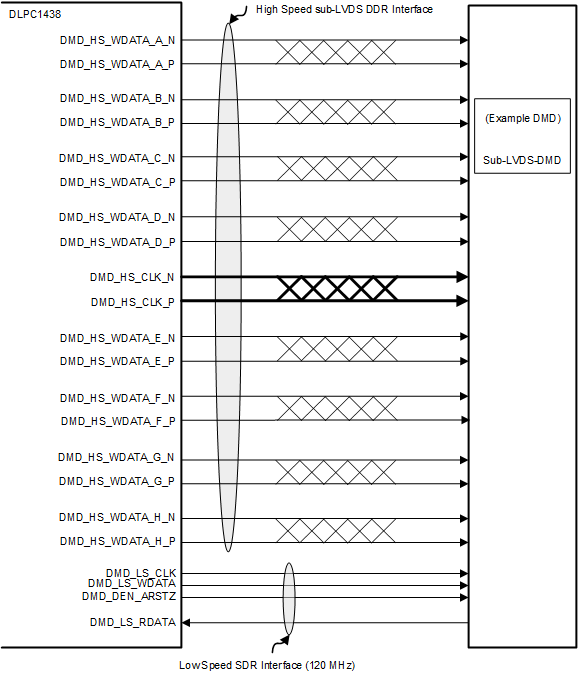JAJSMH2A July 2021 – August 2021 DLPC1438
PRODUCTION DATA
- 1 特長
- 2 アプリケーション
- 3 概要
- 4 Revision History
- 5 Pin Configuration and Functions
-
6 Specifications
- 6.1 Absolute Maximum Ratings
- 6.2 ESD Ratings
- 6.3 Recommended Operating Conditions
- 6.4 Thermal Information
- 6.5 Power Electrical Characteristics
- 6.6 Pin Electrical Characteristics
- 6.7 Internal Pullup and Pulldown Electrical Characteristics
- 6.8 DMD Sub-LVDS Interface Electrical Characteristics
- 6.9 DMD Low-Speed Interface Electrical Characteristics
- 6.10 System Oscillator Timing Requirements
- 6.11 Power Supply and Reset Timing Requirements
- 6.12 Parallel Interface Frame Timing Requirements
- 6.13 Parallel Interface General Timing Requirements
- 6.14 BT656 Interface General Timing Requirements
- 6.15 Flash Interface Timing Requirements
- 6.16 Other Timing Requirements
- 6.17 DMD Sub-LVDS Interface Switching Characteristics
- 6.18 DMD Parking Switching Characteristics
- 6.19 Chipset Component Usage Specification
- 7 Detailed Description
- 8 Application and Implementation
- 9 Power Supply Recommendations
- 10Layout
- 11Device and Documentation Support
- 12Mechanical, Packaging, and Orderable Information
7.3.7.1 Sub-LVDS (HS) Interface
The DLP300S/DLP301S DMD does not require all of the available output data lanes of the controller. Internal software selection allows the controller to support multiple DMD interface swap configurations. These options can improve board layout by remapping specific combinations of DMD interface lines to other DMD interface lines as needed. Table 7-9 shows the two options available for the DLP300S/DLP301S DMD. Leave any unused DMD signal pairs unconnected on the final board design.
| DLPC1438 CONTROLLER 8 LANE DMD ROUTING OPTIONS | DMD PINS | |||
|---|---|---|---|---|
| OPTION 1 | OPTION 2 | |||
| HS_WDATA_D_P HS_WDATA_D_N | HS_WDATA_E_P HS_WDATA_E_N | Input DATA_p_0 Input DATA_n_0 | ||
| HS_WDATA_C_P HS_WDATA_C_N | HS_WDATA_F_P HS_WDATA_F_N | Input DATA_p_1 Input DATA_n_1 | ||
| HS_WDATA_B_P HS_WDATA_B_N | HS_WDATA_G_P HS_WDATA_G_N | Input DATA_p_2 Input DATA_n_2 | ||
| HS_WDATA_A_P HS_WDATA_A_N | HS_WDATA_H_P HS_WDATA_H_N | Input DATA_p_3 Input DATA_n_3 | ||
| HS_WDATA_H_P HS_WDATA_H_N | HS_WDATA_A_P HS_WDATA_A_N | Input DATA_p_4 Input DATA_n_4 | ||
| HS_WDATA_G_P HS_WDATA_G_N | HS_WDATA_B_P HS_WDATA_B_N | Input DATA_p_5 Input DATA_n_5 | ||
| HS_WDATA_F_P HS_WDATA_F_N | HS_WDATA_C_P HS_WDATA_C_N | Input DATA_p_6 Input DATA_n_6 | ||
| HS_WDATA_E_P HS_WDATA_E_N | HS_WDATA_D_P HS_WDATA_D_N | Input DATA_p_7 Input DATA_n_7 | ||
 Figure 7-2 DLP300S/DLP301S DMD
Interface Example
Figure 7-2 DLP300S/DLP301S DMD
Interface ExampleThe sub-LVDS high-speed interface waveform quality and timing on the DLPC1438 controller depends on the total length of the interconnect system, the spacing between traces, the characteristic impedance, etch losses, and how well matched the lengths are across the interface. Thus, ensuring positive timing margin requires attention to many factors.
In an attempt to minimize the signal integrity analysis that would otherwise be required, the DMD Control and Sub-LVDS Signals layout section is provided as a reference of an interconnect system that satisfy both waveform quality and timing requirements (accounting for both PCB routing mismatch and PCB signal integrity). Variation from these recommendations may also work, but should be confirmed with PCB signal integrity analysis or lab measurements.